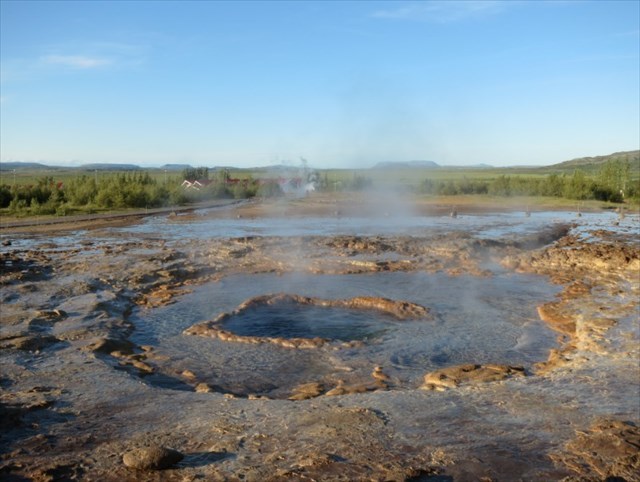 The first tales of the Great Geysir are from over 800 years ago when a powerful earthquake shook Iceland and changed the geothermal area in Haukadalur valley. In written annals tales report that "large hot springs" were formed, now thought to indicate that the hot springs started to spout. The fame of the area increased in the following centuries, and especially that of the Geysir itself. This was not surprising as erupting geysers were at the time not known in Europe outside Iceland. The geysers in Yellowstone and New Zealand obviously were not discovered at that time.
The first tales of the Great Geysir are from over 800 years ago when a powerful earthquake shook Iceland and changed the geothermal area in Haukadalur valley. In written annals tales report that "large hot springs" were formed, now thought to indicate that the hot springs started to spout. The fame of the area increased in the following centuries, and especially that of the Geysir itself. This was not surprising as erupting geysers were at the time not known in Europe outside Iceland. The geysers in Yellowstone and New Zealand obviously were not discovered at that time.

During the centuries the intensity of the thermal ares apparently increased after large earthquakes, striking on average every 100 years.
Sadly the once great Geysir has somewhat faded out and been "shy" for a couple of decades. However, another geyser which is less than 50m from Geysir erupts every 6-9 minutes or so. So you will see a geyser erupt or spout if and when you visit.
The geothermal area which is named after the famous Great Geysir is a high temperature geothermal area. This term is used over geothermal systems that are within the zone of active rifting and volcanism, and the temperature in the subsurface system is higher than 200°C at less than 1 km depth.
The Geysir thermal ares is one of the smallest in Iceland, covering some 3 km2 at the surface.
The thermal ares is at the eastern margin of the western volcanic zone, and differs from other high temperature areas in that no volcanic activity has been in the area during the last 10.000 years (in Holocene).
Studies on the chemistry of the water in the hot springs indicates a subsurface temperature near 240°C, i.e. in the geothermal system at a depth of 1 km or more.
Geysers erupt because the thermal water ascending throuh ther channels boils at some depth below the surface.
As the water boils it flashes into steam, and as the steam occupies far greater volume than water the water above in the channel is thrown high up into the air. At about 23 m depth in the Geysir pipe the water is at 120°C temperature. It is in equilibrium with the pressuere of the water above in the pipe, i.e. the weight of the water above keeps the boiling down.

At a depth of around 16 m, the temperature of the water sometimes rises above boiling, seen as increased turbulence at the surface.
This turbulence (boiling) can increase to the point where the water above in the pipe is lifted slightly, and a chain reaction starts - the pressure decreases making further boiling possible and the water flashes into steam, resulting in an eruption in Geysir.
The boiling now extends down into the pipe, throwing more water into the air. When all the water in the pipe has been thrown away the water coming from depth changes immediately into steam and a steam eruption follows the water eruption, whith accompanying noise.
The water-phase lasts for few minutes and the steam-phase considerably longer, graduately dying out and the cycle starts again.
As the steam-phase dies out the water has drained the channels deep into the earth and it will take 8-10 hours for Geysir to regain its water.
To log this cache, it would be very kind of you to post a picture of you and your gps in front of the Geysir sign or in front of the sparkling spring.
Please, before logging, answer following questions:
1.) The name of todays most popular active spring (in this area)
2.) What´s the name of the German chemist, who discoverd 1846 the real reason of the eruptions.
3.) When was the first activity of the "great geysir"
4.) While waiting on the next eruption you can see the water moving. Describle the flow (how to move)?
5.) Tell me if you ´ll get wet, if you sit on the nearest bench/seat to watch the eruption of the active spring
Logs without answers-mails will be deleted. You don´t have to wait for permission. I´ll contact you, if there is a problem. But please send answers first, then log online.
Don´t post the answers in your log.
Please feel free to log your visit with more than just 5 words. It´s such a great and impressive place, isn´t it worth a few more words ??
Enjoy Iceland !!
German speaking Cachers are invited to discover my Island-Coin: